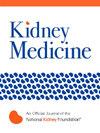RECOVID: covid -19相关AKI患者肾脏结局和长期死亡率的回顾性观察研究,接种疫苗和未接种疫苗患者的比较
IF 3.4
Q1 UROLOGY & NEPHROLOGY
引用次数: 0
摘要
基本原理及急性肾损伤(AKI)是冠状病毒病-2019 (COVID-19)感染患者的常见并发症,发生率高达32%至46%,并与不良预后相关。然而,COVID-19和AKI住院患者的长期肾脏和生存结局尚不完全清楚。研究设计:单中心队列研究。设置,参与者:从2022年3月1日至3月30日,在一个大型城市学术医疗中心,共有972名因COVID-19感染和AKI入院的成年患者。其中,411人(42.3%)未接种美国fda批准的COVID-19疫苗,467人(48.0%)已完成一次疫苗系列。暴露以疫苗接种状况作为暴露点,分析COVID-19感染和AKI住院患者。其他暴露因素包括人口统计学、合并症和住院期间持续肾替代治疗(CRRT)的需要。主要终点为住院死亡率。次要结局包括长期死亡率、住院时间和出院时是否需要肾脏替代治疗(RRT)。分析方法使用描述性分析对接种疫苗和未接种疫苗的队列进行特征描述。使用Kaplan-Meier方法对队列进行分析,使用log-rank检验对组进行比较。分别对死亡率、出院时RRT状态和住院时间使用多变量cox、logistic和线性回归模型。结果3527例COVID-19感染住院患者中,有972例发生AKI。在972例AKI患者中,411例(42.3%)未接种美国fda批准的COVID-19疫苗,467例(48.0%)完成了一次疫苗系列。未接种疫苗的患者在住院期间需要CRRT的比例高于接种疫苗的患者(15.8% vs 10.9%, P = 0.03)。住院期间CRRT与院内死亡显著相关(调整后HR 2.82;95% CI, 1.88-4.25)和长期随访死亡(调整后HR 2.44;95% ci, 1.73-3.42)。与接种疫苗的患者相比,未接种疫苗的患者在RRT上出院的几率也高出2.56倍(95% CI, 1.52-4.30)。在一项调整后的多变量分析中,未接种疫苗者的住院死亡率均显著增加(调整后的HR 5.54;95% CI, 3.36-9.13)和长期随访死亡率(调整后HR 4.78;95% CI, 3.39-6.73)。在重症监护病房接受CRRT的患者中,缺乏通气状态和其他感染严重程度指标的数据。此外,缺乏COVID-19加强疫苗接种的数据。结论接种疫苗的COVID-19感染和AKI患者总体生存期增加,出院时继续RRT的可能性较小。进一步研究评估AKI的潜在病因和COVID-19感染住院患者(包括接种疫苗和未接种疫苗的患者)的肾脏结局,对于开发靶向治疗、指导管理和随访方法以监测肾脏恢复以及为这些患者提供慢性肾脏疾病护理的模型结果具有重要意义。急性肾损伤(AKI)是未接种疫苗和接种疫苗的住院新冠病毒感染患者的常见并发症。这项对972例患者的研究表明,未接种疫苗的COVID-19感染和急性肾脏疾病住院患者的住院死亡率和长期死亡率高于接种疫苗的患者。在411名未接种疫苗的患者中,三分之一在医院死亡,近一半在长期随访中死亡,而接种疫苗的患者死亡人数不到五分之一。与接种疫苗的患者相比,未接种疫苗的患者住院时间更长,住院期间需要持续肾脏替代治疗的比例更高,出院时对肾脏替代治疗的依赖程度也更高。本文章由计算机程序翻译,如有差异,请以英文原文为准。

RECOVID: Retrospective Observational Study of Renal Outcomes and Long-Term Mortality in Patients With COVID-19-Associated AKI, A Comparison Between Vaccinated and Unvaccinated Patients
Rationale & Objective
Acute kidney injury (AKI) is a common complication in patients with Coronavirus disease-2019 (COVID-19) infections, with rates as high as 32% to 46%, and it has been associated with poor outcomes. However, the long-term renal and survival outcomes among hospitalized patients with COVID-19 and AKI are not fully understood.
Study Design
A single-center cohort study.
Setting & Participants
Total of 972 adult patients admitted with COVID-19 infection and AKI at a single large urban academic medical center from March 1, 2022, to March 30, 2022. Among these, 411 (42.3%) did not receive a dose of a US FDA-approved COVID-19 vaccine, and 467 (48.0%) had completed the primary vaccine series.
Exposure
Patients admitted with COVID-19 infection and AKI were analyzed using vaccination status as the exposure. Additional exposures included demographics, comorbid conditions, and need for continuous renal replacement therapy (CRRT) during hospitalization.
Outcome
The primary outcome was in-hospital mortality. Secondary outcomes included long-term mortality, length of hospital stay, and the need for renal replacement therapy (RRT) at discharge.
Analytical Approach
The vaccinated and unvaccinated cohorts were characterized using descriptive analyses. The cohorts were analyzed using the Kaplan-Meier method and groups were compared using the log-rank test. Multivariable cox, logistic, and linear regression models were used for mortality, RRT status at discharge, and length of stay, respectively.
Results
Among 3,527 hospitalized patients with a COVID-19 infection, AKI occurred in 972 patients. Of the 972 patients with AKI, 411 (42.3%) did not receive a dose of a US FDA-approved COVID-19 vaccine and 467 (48.0%) had completed the primary vaccine series. Unvaccinated patients had a higher rate of requiring CRRT during their hospitalization compared with vaccinated patients (15.8% vs 10.9%, P = 0.03). The CRRT during hospitalization was significantly associated with in-hospital death (adjusted HR 2.82; 95% CI, 1.88-4.25) and long-term follow-up death (adjusted HR 2.44; 95% CI, 1.73-3.42). Unvaccinated patients also had a 2.56 (95% CI, 1.52-4.30) times higher odds of being discharged on RRT when compared with those who were vaccinated. In an adjusted multivariable analysis, those who were unvaccinated had both significantly increased in-hospital mortality (adjusted HR 5.54; 95% CI, 3.36-9.13) and long-term follow-up mortality (adjusted HR 4.78; 95% CI, 3.39-6.73) when compared with those who were vaccinated.
Limitations
There was a lack of data on the ventilation status and other indicators of infection severity in patients in intensive care unit who received CRRT. In addition, data on booster COVID-19 vaccinations were lacking.
Conclusions
Vaccinated patients with a COVID-19 infection and AKI had an increase overall survival and were less likely to remain on RRT at the time of discharge. Further studies evaluating the underlying etiologies of AKI and renal outcomes among patients admitted with COVID-19 infection in both vaccinated and unvaccinated patients is important in the development of targeted therapies and guidance on management and follow-up approaches to monitor renal recovery and model outcomes for providing chronic kidney disease care for these patients.
Plain Language Summary
Acute kidney injury (AKI) is a common complication among unvaccinated and vaccinated patients hospitalized with Coronavirus disease-2019 COVID-19 infection. This study of 972 patients demonstrated that unvaccinated patients hospitalized with COVID-19 infection and acute kidney disease had increased in-hospital and long-term mortality compared with vaccinated patients. Among the 411 unvaccinated patients, a third died in the hospital and almost a half died at long-term follow-up compared with less than a fifth in vaccinated patients. Unvaccinated patients also had longer duration of hospitalizations and higher rates of needing continuous renal replacement therapy during hospitalization and renal replacement therapy dependence on discharge compared with vaccinated patients.
求助全文
通过发布文献求助,成功后即可免费获取论文全文。
去求助

 求助内容:
求助内容: 应助结果提醒方式:
应助结果提醒方式:


